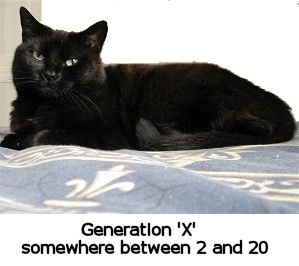How old is that cat?

Unlike most humans, cats age very gracefully. In most healthy cats, there not enough signs of ageing for it to be possible to tell at a glance if you are looking at a sprightly youngster or a mature grandparent. This makes it hard to estimate a cat's age. If you donít know when the cat was born and that cat is already fully grown, even an experienced vet can only give a rough estimate.
There are however a number of things which can help with a guesstimation:
Teeth
By far the best indication of catís age are the teeth, particularly in very young cats. All of a catís baby teeth are present when the kitten reaches 2 months. So if the kitten is missing some baby teeth it is probably younger than 2 months. The first teeth to poke through are the incisors (the very front teeth). These are visible within the first month. Then come the canines (the long front teeth) and finally the lower jaw premolars. The baby teeth are replaced with permanent teeth when the cat is 5-7 months old.
Cats younger than a year old tend to have teeth that are white and clean. The first signs of yellowing are apparent when a cat is somewhere between one and two years old. Then things get more complicated. With age, the teeth accumulate more and more tartar, so by five or six years, most cats will have a visible tartar buildup on all teeth. This has become quite heavy by the time a cat is between 10 and 15 years old. By then a tooth or two may have gone missing as well. But tartar is not a completely reliable guide, because the buildup is affected by the catís diet. Also modern cats often have the benefit of veterinary dentistry, so it is not unusual for older cats to have gleaming teeth with the tartar recently cleaned away.
Eyes
As also happens with humans, the possibility of a cat developing cataracts can increase as the cat ages. Eyes that appear to be cloudy with a whitish or opaque appearance may indicate that the cat has cataracts. This would suggest that the cat in question is more than 12 years old. As a cat ages her pupils may also acquire a greenish or bluish transparent tinge. The medical name for this is lenticular sclerosis. This seems to be a condition associated with normal ageing. Unlike with cataracts, vision does not seem to be affected by lenticular sclerosis.
Another age indicator is the iris. In young cats the iris is very smooth. As a cat ages the iris may become more jagged looking. This is known as iris atrophy and it is more visible in lighter-coloured cats. Again the vision does not seem to be affected, although some cats may be a bit more light-sensitive. However, it is perfectly possible for a twenty-year old cat to have the eyes of a two-year old, so while the presence of the above signs can give a clue, their absence is less helpful.
Middle-age spread
Yes, this not only happens to us humans but to cats as well. Cats between six and nine years old often lose their youthful sleekness and start rounding out. There is more loose skin hanging around the tummy area (the so-called Ďaproní) and the catís muscles are less firm. As with humans, middle-age spread is optional and reversible. That it happens at all is largely due to changes in behaviour. Mature cats, like mature humans, tend to become less active. Snoozing on a comfortable sofa is more fun than toys. But with both humans and cats, some individuals remain highly active, and enjoy physical activity and active games right through maturity into old age. With cats the degree of playfulness is often associated with how much play time a cat gets on a regular basis. However, there is no doubt that adult and senior cats are less impressed by cat toys than youngsters.
Coat
Another aspect of feline aging that humans might envy is that aging does not cause cats to go bald and a catís fur does not turn gray with age. A black cat will be a black cat whether two or nineteen years old (although white coats often acquire a yellowish tinge in older cats). Nevertheless, subtle changes to the coat can be detected in senior cats. The coat will be less plush and while cats may escape balding, the fur might have thinning in places. The coat will also feel somewhat coarser. But remember that cats have a winter and summer coat so the pelt will always be thinner in summer and thicker in winter.
Overall
Cats definitely have the edge on humans on this aspect of life. While cats might become lazier and less emotional as they get older, their muscles stay toned, their hair keeps its colour and their teeth stay sharp. It might be fair to say that humans age - but cats mature.
